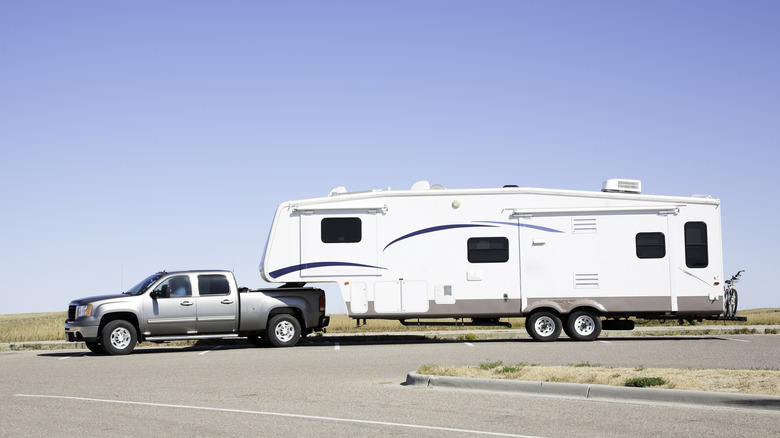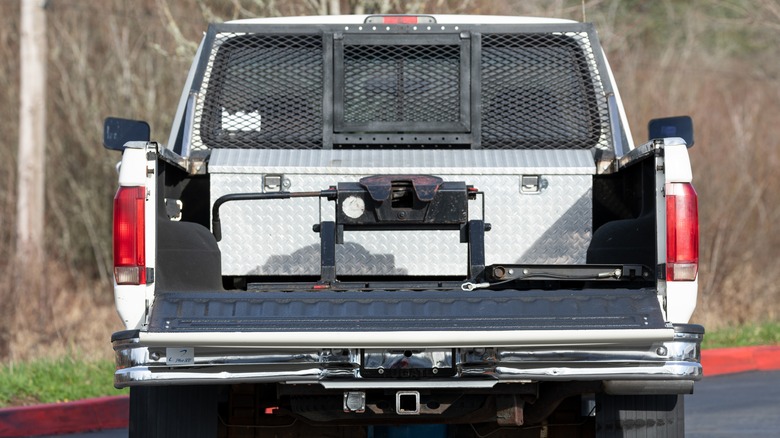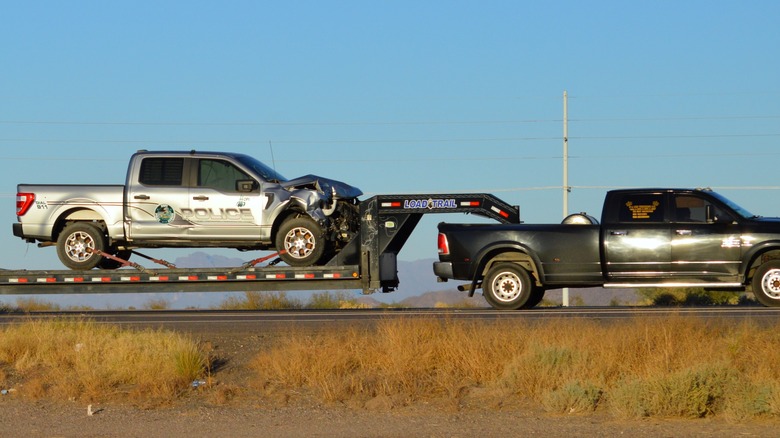Gooseneck Vs. 5th Wheel Trailer Hitches: Pros, Cons, And Major Differences
We may receive a commission on purchases made from links.
One of the major perks of owning a big, powerful truck is the ability to haul large loads with the help of various accessories. Even if an object is physically too large to carry around in the bed of your truck, such as a trailer or a camper, you can still take it with you by hitching it to your truck and having it trail behind you. As long as you know how to drive a vehicle with an attached load like this, being able to hitch stuff up to your truck gives you a lot more carrying capacity than you would have with the bed alone. You might want to give a little consideration, however, to the precise kind of hitch you're using, as different setups have slightly different applications.
Two of the most prominent forms of trailer hitches used by trucks today are the gooseneck hitch and the 5th wheel hitch. A gooseneck hitch is much simpler, with the only distinctive element being a silver orb sticking up out of your truck's bed. A 5th wheel hitch, meanwhile, has a higher profile, as it's an entirely separate device that must be mounted to the bed. Both hitch types can handle loads of comparable weight, but the precise way they're installed, as well as how they bend and move while in motion, may influence your decision on which to go with before hitching up.
A gooseneck is a low-profile hitch that is mounted directly to your truck's body
If you're making a habit of hauling trailers around, whether professionally or just because you've become the unofficial moving person for your friends, you might want to get a hitching mount that can effectively utilize your truck's full hauling capacity. In such a case, a gooseneck may be the hitch you want.
A gooseneck hitch is a relatively simple system that's mounted in the bed of your truck, usually in the vicinity of the rear axle. The setup needs to be attached to the truck's frame, with the distinctive silver hitching sphere poking up through the bed. If your truck doesn't already have fittings for this, you might have to get a hole cut into the bed during the installation process.
Because the gooseneck is built right into your truck, it's able to endure wider, heavier loads. Even a basic gooseneck hitch can haul loads of over 30,000 pounds, and the swiveling joint provided by the sphere gives you a little extra flexibility on the road. Plus, since the only part that sticks out is the sphere, it frees up lots of space in your truck bed if you want to carry some other assorted items while you're hauling a trailer.
A 5th wheel is a hitching device that's mounted to your truck's bed
If you're not into the idea of attaching a gooseneck hitch directly into your truck's body, then you may appreciate the more modular design of a 5th wheel hitch. Rather than a static towing point, a 5th wheel is a standalone device that's mounted to your truck bed, creating a connection with a towed load via jaws that lock in the kingpin, which is attached to the trailer, and a hitch head that pivots.
There are a variety of 5th wheel hitches available with different, finely tuned towing capacities. Depending on the precise hitch you use, you could haul loads ranging from 16,000 to 30,000 pounds in weight. The more mechanically complex designs of 5th wheel hitches result in a generally smoother towing experience, not to mention a quieter one.
Having a 5th wheel hitch installed can be a bit of a time-consuming process, but once you have the mount set up, you can then detach it from the mount or reattach it as necessary. This is nice if you don't make a habit of hauling loads around regularly, as it returns the full capacity of your truck bed to you. A 5th wheel hitch takes up much of the truck bed, so you can't exactly leave it in there all the time.
Goosenecks are better for pros, while 5th wheels are better for casual hauling
Both gooseneck and 5th wheel hitches have their major applications, but in a nutshell, the former is better suited for hefty, professional work like commercial transportation, while the latter is better for recreational hauling like bringing a camper with you on vacation.
Given its lower profile and greater carrying capacity, a gooseneck is vital for professional movers and haulers who need to tow large objects and place smaller objects in the truck bed all at the same time. The coupling mechanism is relatively simple, which helps a pro get on and off the road faster. A gooseneck is a bit less stable on the road, however, which can result in a lot of annoying rattling and shaking.
A 5th wheel hitch can't carry as much as a gooseneck, and its much higher profile can be annoying if you were hoping to use your truck bed. This makes a 5th wheel a good "sometimes hitch" — something you only need to bust out occasionally to bring your camping trailer with you or help a friend. When you don't need it anymore, just take the hitch off, and you've got your truck bed back. In addition, when you do haul with it, it can smoothly handle a variety of different loads.



